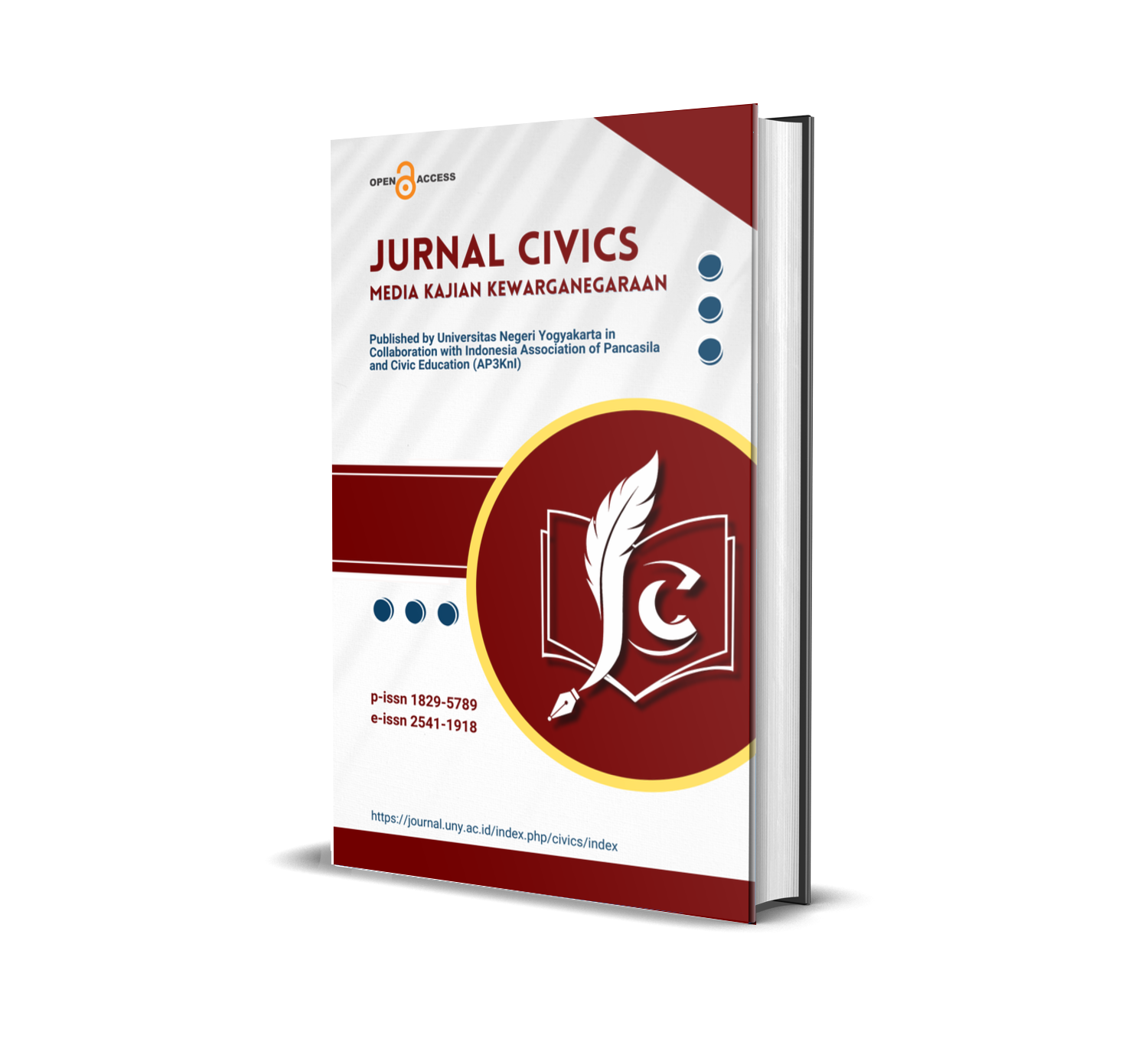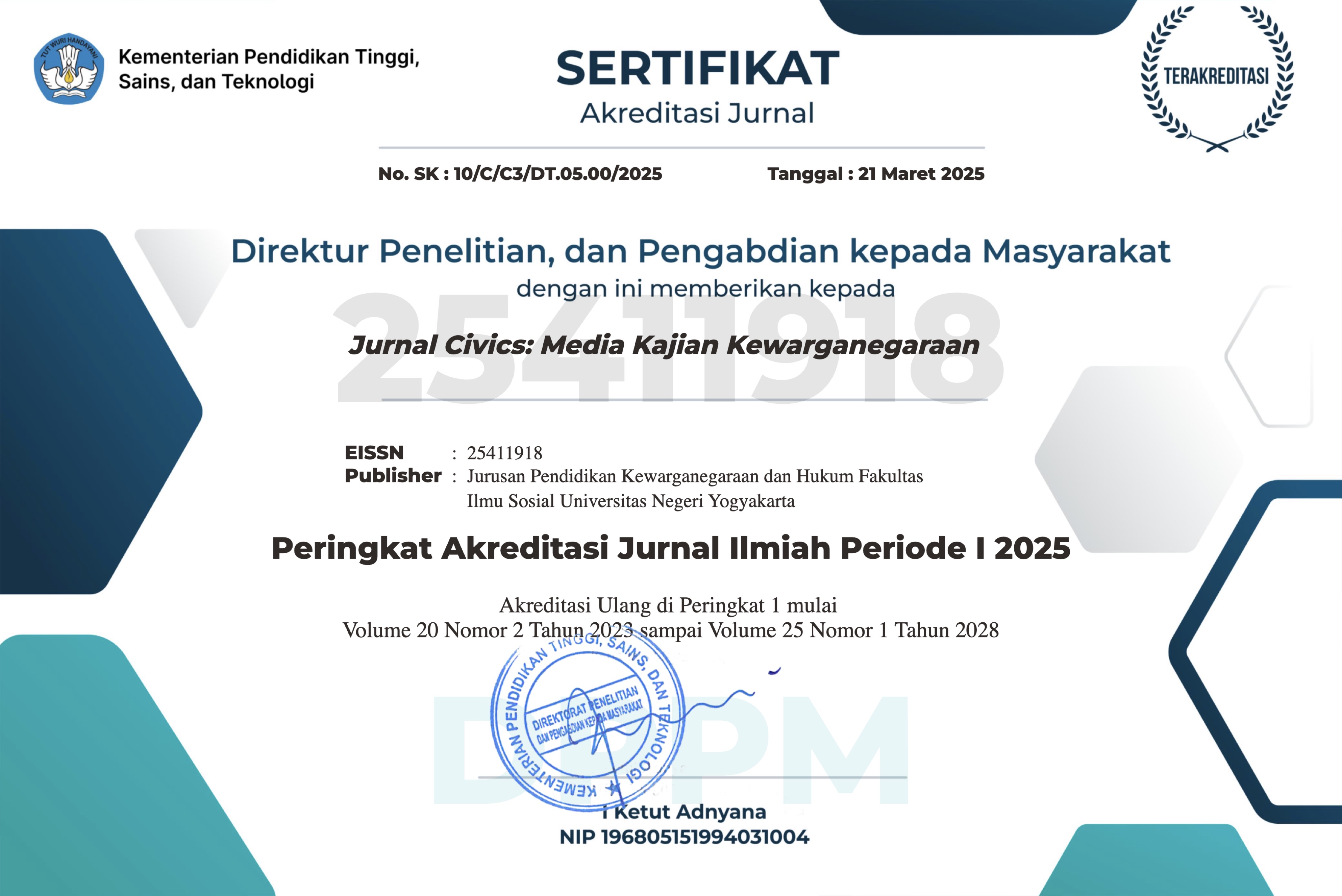Elsinta radio's social message to build the value of communication wisdom and citizens cultural identity
DOI:
https://doi.org/10.21831/jc.v19i2.53527Keywords:
social message, citizenship, cultural identity, local wisdom, value,Abstract
As an interactive media, a radio has social responsibility to the community on the understanding the policy of multicultural education from language diversity point of view. This study was to analyze the existence of radio as a type of electronic media that has a role and function as a medium of information, education, and entertainment for the community. We approached the study focus by using theory of multicultural education value, and supported by the theory of social media responsibility. The results of the study showed that Elsinta as one of the private radio stations in Indonesia through the broadcast content of RBI which had become a radio characteristic in presenting broadcast material that need to be used as a capital and model to develop multicultural communication education innovations. Therefore, to build a community perspective, it was necessary to be based on the value of the wisdom of the diversity of languages in Indonesia, packaged into learning materials for the community. This study contributes academically to the community as an effort to strengthen the value of the wisdom of language diversity.
References
Adzra, G. A. (2020). Pengaruh penyiaran Radio Republik Indonesia Banjarmasin pada program acara Banjar Realita. Jurnal Mutakallimin : Jurnal Ilmu Komunikasi, 2(2), 31–36. https://ojs.uniska-bjm.ac.id/index.php/mutakallimin/article/view/3516
Basit, N. (2022). 15 reasons why radio is important. https://curiousdesire.com/importance-of-radio/
Candiasa, I. M., Mertasari, N. M. S., & Aryanta, M. (2021). Social media as integrated character education media. Journal of Physics: Conference Series, 1810(1), 012073. https://doi.org/10.1088/1742-6596/1810/1/012073
Cariffe, J. (n.d.). 10 reasons radio is more relevant than ever. Retrieved March 12, 2023, from https://www.bonnevillebayarea.com/blog/10-reasons-radio-is-more-relevant-than-ever
Chairiawaty. (2019). Pemaknaan perempuan kepala keluarga tentang pesan-pesan pada Radio Komunitas Pekka FM. Communicatus: Jurnal Ilmu Komunikasi, 3(2), 101–122. https://doi.org/10.15575/cjik.v3i2.5785
Chandra, S., & Aminudin, A. (2019). Peran Ben’s radio dalam melestarikan budaya Betawi pada program begaya. Jurnal Jurnalisa, 5(2), 262–272. https://journal.uin-alauddin.ac.id/index.php/jurnalisa/article/view/10311
Coleman, J. S. (2008). Dasar-dasar teori sosial (Dariyanto, Ed.). Nusa Media.
Creswell, J. W., & Poth, C. N. (2018). Qualitative inquiry & research design: Choosing among five approaches (4th ed.). SAGE.
EDC. (2020). A badio-based approach to learning during COVID-19 | EDC. https://www.edc.org/radio-based-approach-learning-during-covid-19
Effendy, R. (2016). Program siaran interaktif (Talk Back Radio) sebagai ruang publik masyarakat untuk mengembangkan demokrasi lokal: Studi pada Program ”Citra Publika” Radio Citra 87,9 FM Kota Malang. Jurnal Komunikasi, 9(1), 1–16. https://journal.uii.ac.id/jurnal-komunikasi/article/view/6545
Encyclopedia.com. (n.d.). Radio and the power of broadcasting . Retrieved March 12, 2023, from https://www.encyclopedia.com/defense/energy-government-and-defense-magazines/radio-and-power-broadcasting
Ferdig, R. E., Coutts, J., DiPietro, J., Lok, B., & Davis, N. (2007). Innovative technologies for multicultural education needs. Multicultural Education & Technology Journal, 1(1), 47–63. https://doi.org/10.1108/17504970710745201
Greeves, S. B., & Ledbetter, R. N. (2022). Science communication in public radio: The case study of mindtap. Frontiers in Communication, 7, 129. https://doi.org/10.3389/FCOMM.2022.889207/BIBTEX
Innayah, & Susanti, M. (2016). Peran serta pendengar dan lembaga pemerintah dalam siaran radio pendidikan. Jurnal Pekommas, 1(1), 21–32. https://doi.org/10.30818/JPKM.2016.2010103
Insideradio. (n.d.). Americans may love social media, but survey finds it’s radio that they trust. Retrieved March 12, 2023, from https://www.insideradio.com/free/americans-may-love-social-media-but-survey-finds-it-s-radio-that-they-trust/article_870935aa-84cc-11ec-813e-670dc49c576c.html
Juditha, C., & Darmawan, J. J. (2016). Terapan siaran RRI dan TVRI pada masyarakat di wilayah perbatasan RI-Timor Leste. Jurnal Komunika : Jurnal Komunikasi, Media Dan Informatika, 5(1), 19–28. https://doi.org/10.31504/komunika.v5i1.635
Laor, T. (2022). Radio on demand: New habits of consuming radio content. Global Media and Communication, 18(1), 25–48. https://doi.org/10.1177/17427665211073868
Mastriaco, D. (2022). The power of radio in 2022. https://blog.tritondigital.com/the-power-of-radio-in-2022
Oktavia, W., & Hayati, N. (2020). Pola karakteristik ragam bahasa istilah pada masa pandemi Covid-19. Tabasa: Jurnal Bahasa, Sastra Indonesia, Dan Pengajarannya, 1(1), 1–15. https://doi.org/10.22515/tabasa.v1i1.2607
Prahmana, R. C. I., Hartanto, D., Kusumaningtyas, D. A., Ali, R. M., & Muchlas. (2021). Community radio-based blended learning model: A promising learning model in remote area during pandemic era. Heliyon, 7(7), e07511. https://doi.org/10.1016/J.HELIYON.2021.E07511
Priana, R. Y. S., & Nurjuman, H. (2022). Effectiveness of delivering information and social messages through radio programs during the Covid-19 pandemic. Journal of Business Studies and Mangement Review, 6(1), 53–57. https://doi.org/10.22437/jbsmr.v6i1.21500
Rabiah, S. (2016). Ragam bahasa Indonesia dalam komunikasi politik. The Politics : Jurnal Magister Ilmu Politik Universitas Hasanuddin, 2(1), 121–131. http://journal.unhas.ac.id/index.php/politics/article/view/1661
Sanusi, B. O., Talabi, F. O., Adelabu, O. T., & Alade, M. (2021). Educational radio broadcasting and its effectiveness on adult literacy in Lagos. SAGE Open, 11(2), 215824402110163. https://doi.org/10.1177/21582440211016374
Prayudi, S., & Nasution, W. (2020). Ragam bahasa dalam media sosial Twitter: Kajian sosiolinguistik. Jurnal Metamorfosa, 8(2), 269–280. https://doi.org/10.46244/metamorfosa.v8i2.1140
Starkey, G., & Crisell, A. (2009). Radio journalism. SAGE Publications Ltd. https://doi.org/10.4135/9781446214350
Waridah, W. (2018). Ragam bahasa jurnalistik. JURNAL SIMBOLIKA: Research and Learning in Communication Study (E-Journal), 4(2), 112–129. https://ojs.uma.ac.id/index.php/simbolika/article/view/1822
Downloads
Published
How to Cite
Issue
Section
Citation Check
License
The authors agree to transfer the transfer copyright of the article to The Jurnal Civics: Media Kajian Kewarganegaraan effective if and when the paper is accepted for publication.
Authors and other parties are bound to the Creative Commons Attribution-NonCommercial-ShareAlike 4.0 International License for the published articles, legal formal aspect of journal publication accessibility refers to Creative Commons Attribution-NonCommercial-ShareAlike 4.0 International License (CC BY-NC-SA).










